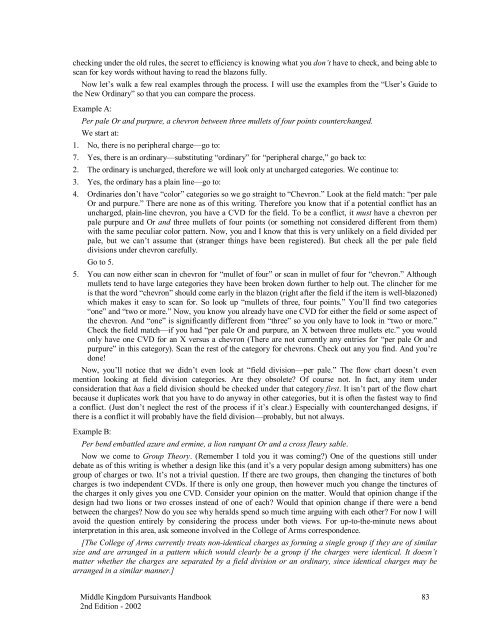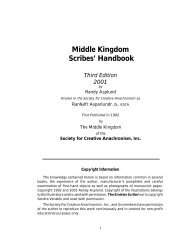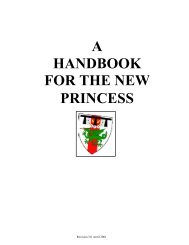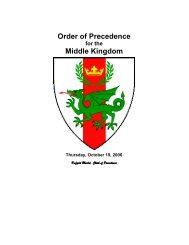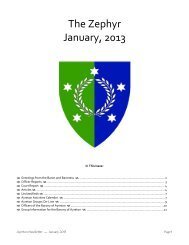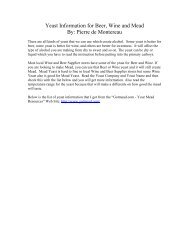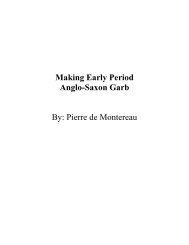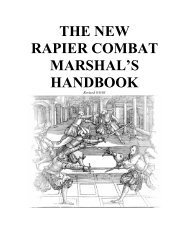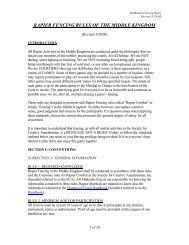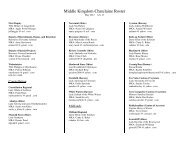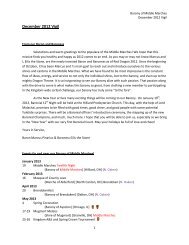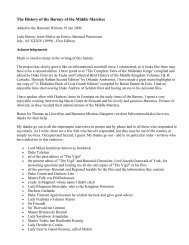Middle Kingdom Pursuivants Handbook 2nd Edition - Midrealm ...
Middle Kingdom Pursuivants Handbook 2nd Edition - Midrealm ...
Middle Kingdom Pursuivants Handbook 2nd Edition - Midrealm ...
You also want an ePaper? Increase the reach of your titles
YUMPU automatically turns print PDFs into web optimized ePapers that Google loves.
checking under the old rules, the secret to efficiency is knowing what you don’t have to check, and being able toscan for key words without having to read the blazons fully.Now let’s walk a few real examples through the process. I will use the examples from the “User’s Guide tothe New Ordinary” so that you can compare the process.Example A:Per pale Or and purpure, a chevron between three mullets of four points counterchanged.We start at:1. No, there is no peripheral charge—go to:7. Yes, there is an ordinary—substituting “ordinary” for “peripheral charge,” go back to:2. The ordinary is uncharged, therefore we will look only at uncharged categories. We continue to:3. Yes, the ordinary has a plain line—go to:4. Ordinaries don’t have “color” categories so we go straight to “Chevron.” Look at the field match: “per paleOr and purpure.” There are none as of this writing. Therefore you know that if a potential conflict has anuncharged, plain-line chevron, you have a CVD for the field. To be a conflict, it must have a chevron perpale purpure and Or and three mullets of four points (or something not considered different from them)with the same peculiar color pattern. Now, you and I know that this is very unlikely on a field divided perpale, but we can’t assume that (stranger things have been registered). But check all the per pale fielddivisions under chevron carefully.Go to 5.5. You can now either scan in chevron for “mullet of four” or scan in mullet of four for “chevron.” Althoughmullets tend to have large categories they have been broken down further to help out. The clincher for meis that the word “chevron” should come early in the blazon (right after the field if the item is well-blazoned)which makes it easy to scan for. So look up “mullets of three, four points.” You’ll find two categories“one” and “two or more.” Now, you know you already have one CVD for either the field or some aspect ofthe chevron. And “one” is significantly different from “three” so you only have to look in “two or more.”Check the field match—if you had “per pale Or and purpure, an X between three mullets etc.” you wouldonly have one CVD for an X versus a chevron (There are not currently any entries for “per pale Or andpurpure” in this category). Scan the rest of the category for chevrons. Check out any you find. And you’redone!Now, you’ll notice that we didn’t even look at “field division—per pale.” The flow chart doesn’t evenmention looking at field division categories. Are they obsolete? Of course not. In fact, any item underconsideration that has a field division should be checked under that category first. It isn’t part of the flow chartbecause it duplicates work that you have to do anyway in other categories, but it is often the fastest way to finda conflict. (Just don’t neglect the rest of the process if it’s clear.) Especially with counterchanged designs, ifthere is a conflict it will probably have the field division—probably, but not always.Example B:Per bend embattled azure and ermine, a lion rampant Or and a cross fleury sable.Now we come to Group Theory. (Remember I told you it was coming?) One of the questions still underdebate as of this writing is whether a design like this (and it’s a very popular design among submitters) has onegroup of charges or two. It’s not a trivial question. If there are two groups, then changing the tinctures of bothcharges is two independent CVDs. If there is only one group, then however much you change the tinctures ofthe charges it only gives you one CVD. Consider your opinion on the matter. Would that opinion change if thedesign had two lions or two crosses instead of one of each? Would that opinion change if there were a bendbetween the charges? Now do you see why heralds spend so much time arguing with each other? For now I willavoid the question entirely by considering the process under both views. For up-to-the-minute news aboutinterpretation in this area, ask someone involved in the College of Arms correspondence.[The College of Arms currently treats non-identical charges as forming a single group if they are of similarsize and are arranged in a pattern which would clearly be a group if the charges were identical. It doesn’tmatter whether the charges are separated by a field division or an ordinary, since identical charges may bearranged in a similar manner.]<strong>Middle</strong> <strong>Kingdom</strong> <strong>Pursuivants</strong> <strong>Handbook</strong> 83<strong>2nd</strong> <strong>Edition</strong> - 2002


